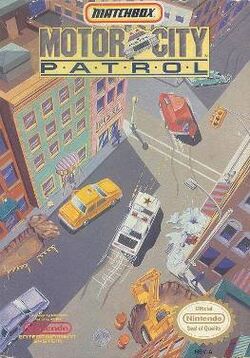Software:Motor City Patrol
| Motor City Patrol | |
|---|---|
 | |
| Developer(s) | Source Research & Development |
| Publisher(s) | Matchbox International |
| Designer(s) | Ross Harris |
| Programmer(s) | Ian Richards |
| Artist(s) | Ross Harris, John Cassels |
| Composer(s) | Chris Gill, Link Tomlin |
| Platform(s) | Nintendo Entertainment System |
| Release |
|
| Genre(s) | Mission-based driving[1] |
| Mode(s) | Single-player |
Motor City Patrol is a top-down driving game released in 1992 for the Nintendo Entertainment System.[2] It was developed by British studio Source Research & Development and published by Matchbox International Ltd.[1]
Motor City Patrol was shown at the Summer Consumer Electronics Show in 1990 and 1991.[3][4] The game was released in January 1992,[1][5] and was Matchbox's first video game.[6]
Motor City Patrol was one in a line of video games that tied into the Matchbox brand of die-cast model vehicles, like police cars, ambulances, fire trucks,[7] and earth-moving construction machines.[2]
Gameplay
The player controls an officer of the law whose job it is to patrol one of five precincts for a week at a time. As the player gets farther and farther into the week, a larger area is permitted to be patrolled, in addition to a longer shift (time limit) to accomplish each of the mission goals.
Players get to drive around all day looking for speeders, robbers, and public enemies, while avoiding hurting innocent civilians. When a criminal (speeder, robber, or public enemy) appears on the precinct map, the player must either pull over or shoot the offender's vehicle. The game ends when players fail in a mission, receive five or more warnings, shoot a civilian, or total their vehicle.
After going through all five precincts (at seven days apiece), players start over again in precinct 1, on day 1, with all of their points, merits, warnings, and car upgrades intact. The game cycles indefinitely until the player loses.
Reception
Skyler Miller of AllGame gave Motor City Patrol two stars out of a possible five, calling it an "interesting but ultimately disappointing game". Miller praised the game's "sharp, detailed rendition" of city streets, but wrote that the execution of the game's "promising" concept "is derailed by repetitive objectives that never change, a difficult-to-control car and the necessity of constantly having to switch to a map screen to see the location of buildings and criminals."[8]
References
- ↑ 1.0 1.1 1.2 Motor City Patrol at GameFAQs
- ↑ 2.0 2.1 "Matchbox licensees". MobyGames. http://www.mobygames.com/game-group/matchbox-licensees.
- ↑ "Nintendo Player". Electronic Gaming Monthly: 42, 71. August 1990. https://archive.org/stream/Electronic_Gaming_Monthly_Issue_013_August_1990#page/n72/mode/1up/. Retrieved 7 September 2017.
- ↑ "CES Show". Zero: pp. 66, 70. September 1991. https://archive.org/stream/ZeroIssue23Sep91/Zero_Issue_23_Sep_91#page/n69/mode/1up/.
- ↑ "Short Pro Shots". GamePro: 128. February 1992. https://archive.org/stream/GamePro_Issue_031_February_1992#page/n129/mode/1up/. Retrieved 7 September 2017.
- ↑ "Next Wave: New Soft News". Electronic Gaming Monthly: 156. October 1991. https://archive.org/stream/Electronic_Gaming_Monthly_Issue_027_October_1991#page/n157/mode/1up/. Retrieved 7 September 2017.
- ↑ "Matchbox: Emergency Patrol". MobyGames. http://www.mobygames.com/game/matchbox-emergency-patrol_.
- ↑ Miller, Skyler. "Rating information for Motor City Patrol". AllGame. http://www.allgame.com/game.php?id=22177&tab=review.
External links
 |


